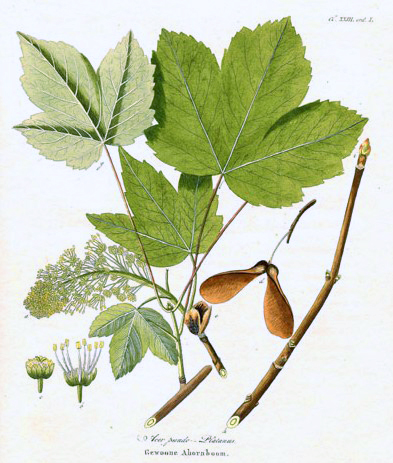- This topic has 0 replies, 1 voice, and was last updated 2 years ago by
 Robert Oglesby DVM.
Robert Oglesby DVM.
-
AuthorPosts
-
-
August 13, 2021 at 10:49 am #20229
 Robert Oglesby DVMKeymaster
Robert Oglesby DVMKeymasterThis paper, though involving deer, serves as a reminder that a increasingly common tree in North America, the sycamore maple (SM, Acer pseudoplatanus), is a cause of muscle disease in horses. This is one of the several causes of tying up, or rhabdomyolysis, that is lumped under the title atypical myopathy in horses. First remember that the sycamore maple is not the same as the common North American sycamore tree. It gets its name because it’s broad leaves, though they have a maple leaf shape, resemble that of the sycamore.

The tree however is far more domed shaped than most sycamores.

From Wikipedia:
The sycamore can grow to a height of about 35 m (115 ft) and the branches form a broad, rounded crown. The bark is grey, smooth when young and later flaking in irregular patches. …
The sycamore has been introduced to suitable locations outside Europe as an attractive tree for park, street or garden. These include the United States, Canada, Australia (Victoria and Tasmania), Chile and New Zealand,[3][30] Patagonia[22] and the laurel forests of Madeira and the Azores.[31]:74 At the time of its introduction it was probably not appreciated that its prolific production of seeds might one day cause a problem to the landscape as it spread and out-competed native species.[32]:334 The tree is now considered to be an environmental weed in some parts of Australia (Yarra Ranges, Victoria) and also Mount Macedon, near Daylesford, parts of the Dandenong Ranges, where it is naturalised in the eucalypt forests.[33] The sycamore is also scattered in north-eastern Tasmania and also at Taroona, near the Derwent River, in southern Hobart. It is considered to be an invasive species in New Zealand,[34] Norway,[35] and environmentally sensitive locations in the United Kingdom.[36]
In about 1870, the sycamore was introduced into the United States, and was planted in New York and New Jersey. It was later cultivated as a park or street tree in New England and the Mid-Atlantic states. By the early part of the 21st century, it was naturalised in fourteen states (Connecticut, Delaware, Illinois, Kentucky, Maine, Michigan, North Carolina, New Jersey, New York, Pennsylvania, Rhode Island and Washington, D.C.), and in the Canadian provinces of British Columbia, New Brunswick, Nova Scotia and Ontario.[37] The United States Department of Agriculture considers it an invasive species.[2]
For more on the signs of tying up, myopathy, or rhabdomyolysis see the parent article to this topic.
DrOMethylenecyclopropylglycine and hypoglycin A intoxication in three Pére David’s Deers (Elaphurus davidianus) with atypical myopathy
Vet Med Sci. 2020 Dec 13.
Authors
Mandy Bochnia 1 , Eva Ziemssen 2 , Johannes Sander 3 , Birgit Stief 4 , Annette Zeyner 1
Affiliations
1 Institute of Agricultural and Nutritional Sciences, Martin Luther University Halle-Wittenberg, Halle (Saale), Germany.
2 Zoo Dresden GmbH, Dresden, Germany.
3 Screening Labor Hannover, Ronnenberg, Germany.
4 Landesuntersuchungsanstalt für das Gesundheits- und Veterinärwesen, Dresden, Germany.Abstract
Background: Hypoglycin A (HGA) and methylenecyclopropylglycine (MCPrG) from seeds/seedlings of Sycamore maple (SM, Acer pseudoplatanus) causes atypical myopathy (AM) in horses. AM was not known to occur in wild ruminants until several fatalities in milus (Elaphurus davidianus) following the ingestion of HGA in SM seeds. However, a role for MCPrG has not previously been evaluated.Objectives: To test the hypothesis that MCPrG is also a major factor in AM in milus, three milus (M1, M2, M3) from the Zoo Dresden (aged 7-11 years, 2 females and 1 male, in good nutritional condition) that developed AM were studied.
Methods: Serum, urine and methanol extracts from the liver, kidney, rumen digesta and faeces were analysed by ultrahigh-performance liquid chromatography-tandem mass spectrometry for HGA, MCPrG and for conjugates of carnitine (C) and glycine (G): Methylenecyclopropylacetyl (MCPA)-G, MCPA-C, Methylenecyclopropylformyl (MCPF)-G, MCPF-C, butyryl-C and isobutyryl-C.
Results: HGA in serum was high (M2 480 nmol/L; M3 460 nmol/L), but MCPrG was not. HGA and MCPrG were found in rumen and faeces extracts, and MCPrG was also identified in the liver. Metabolites of HGA and MCPrG were high in serum, urine and liver, but not in the rumen or faeces.
Conclusions: This study shows that MCPrG is involved in the pathophysiology of AM in milus. The metabolism of MCPrG is considered to be faster because, after ingestion, the specific metabolites appear highly concentrated in the serum. The high toxin concentration in the liver suggests that a possible transfer into products for human consumption may pose a risk.
Keywords: MCPrG; atypical myopathy; hypoglycin A; methylenecyclopropylglycine; rhabdomyolysis; sycamore maple seeds.
-
-
AuthorPosts
- You must be logged in to reply to this topic.